Over more than five decades, Nengudi has developed a practice that encompasses poetic, enigmatic objects and installations as well as performances, films, and photographs exploring the interactions of performers with and amid her three-dimensional works. Despite a long and rich career over more than five decades, she has only come to wider attention more recently, and her achievements find powerful reverberations in contemporary art.
The beginning of Nengudi’s career in the mid-1960s coincided with a tumultuous period in US history, which included the civil rights movement as well as the start of the women’s movement and second-wave feminism. These events were formative for the artist, who would go on to produce ephemeral, often abstract, performance-based, and frequently collaborative works addressing such issues as race, gender, and ethnicity, as well as labor and the passage of time. The intersections of passionate, sometimes conflicting, political concerns among peers, colleagues, and society at large produced an often fraught climate of debate over the most effective ways for artists to address the problems facing society.
As with other Black artists working in abstraction, Nengudi was considered by some to fall short of political urgency or a specific message due to her use of evocation, rather than direct representation, in addressing issues facing Black Americans. Despite initial opposition to her efforts, Nengudi has proceeded over the ensuing decades to develop a generous, versatile artistic practice that demonstrates how abstract sculpture can address political issues with compassion, humor, and a diverse community of allies. Indeed, she has expanded our idea of what can be considered political about a work of art. As she explained in 2018, “Simply by being, that’s a political statement. So, whatever comes out of me has all those elements of me in it: I’m black, I’m a woman, at this point I’m a woman of a certain age, which also has issues related to it. So simply by being, I am those things.” 1
Born in 1943 as Sue Ellen Irons in Chicago, Illinois, Nengudi grew up largely on the west coast, in Pasadena and Los Angeles. Her early interests in art and dance led her to study both, eventually resulting in a bachelor’s degree in art with a minor in dance at Los Angeles State College, followed by a master’s degree in sculpture at the same institution, which by then had changed its name to California State College, Los Angeles. In addition to her formal education, Nengudi has identified her experiences teaching as central to her development—particularly her time in the mid-1960s at the Watts Towers Art Center, which was founded by artist Noah Purifoy in the Black neighborhood of Watts after the 1965 Watts Uprising, near the fantastical complex built by Simon Rodia from found objects. Education has remained important to Nengudi, who continued teaching until her retirement in 2008 from the University of Colorado, Colorado Springs (UCCS) Visual Arts and Performing Arts Department.
In her formative years, Nengudi drew inspiration from a wide range of art. As an educator at the Pasadena Art Museum, she encountered sculptures by some of the most important contemporary artists of the period, including Claes Oldenburg, Craig Kauffman, and Richard Serra. Importantly, these were shown in the context of a varied, cross-cultural exhibition program, ranging from European modernism to Japanese paintings to Ghanaian textiles. She also found inspiration in the example of a slightly older generation of Black artists working in California, such as Melvin Edwards and Betye Saar. A book on the Japanese avant-garde introduced her to the Gutai group, whose radically experimental art movement in post-war Japan challenged traditional means of creation by emphasizing unconventional materials, process over finished artworks, and new contexts for art. 2
Nengudi’s fascination with Gutai prompted her to enter a post-graduate program in Japan in 1966. Although she did not experience Gutai’s works or artists in person, the trip brought her into contact with traditional Noh and Kabuki theater. These would play an important role in the development of her approach to performance, as would the burgeoning interest taken by the Black Arts Movement in traditional forms of African art and their relation to ritual. While Nengudi did not engage in the direct political messaging of some of her peers, the diasporic African experience was key to her conception of artistic identity and practice. In 1974, after three years in New York, she returned to Los Angeles with the name by which she is known today: Senga, as she has explained, means “woman of the village that people come to [for advice]” in the Douala language of Cameroon, while Nengudi connotes a woman who “comes to power as a traditional healer.” 3
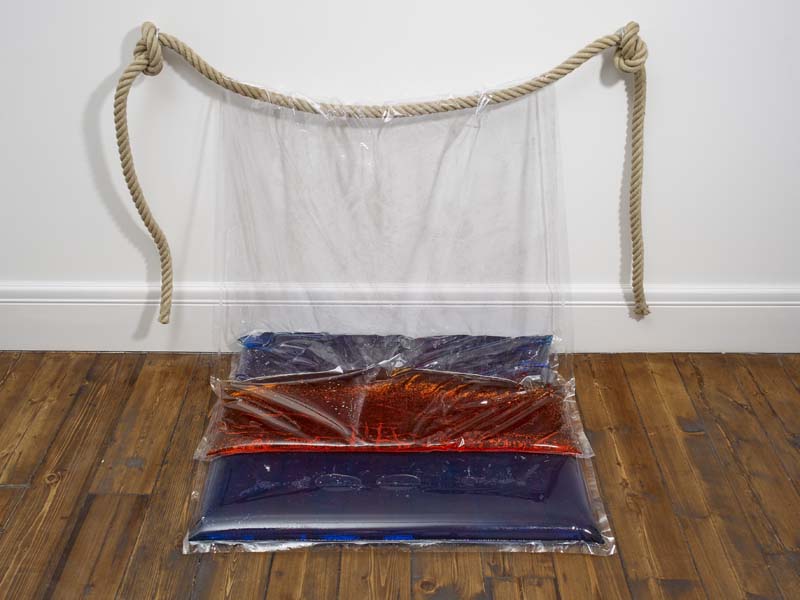 Senga Nengudi
Senga Nengudi
Water Composition III, 1969–70/2018
Heat sealed vinyl, coloured water, rope
35 7/8 × 47 1/4 × 28 3/4 in. (91 × 120 × 73 cm)
© Senga Nengudi, 2022
Courtesy of Sprüth Magers and Thomas Erben Gallery, New York
Photo: Stephen White
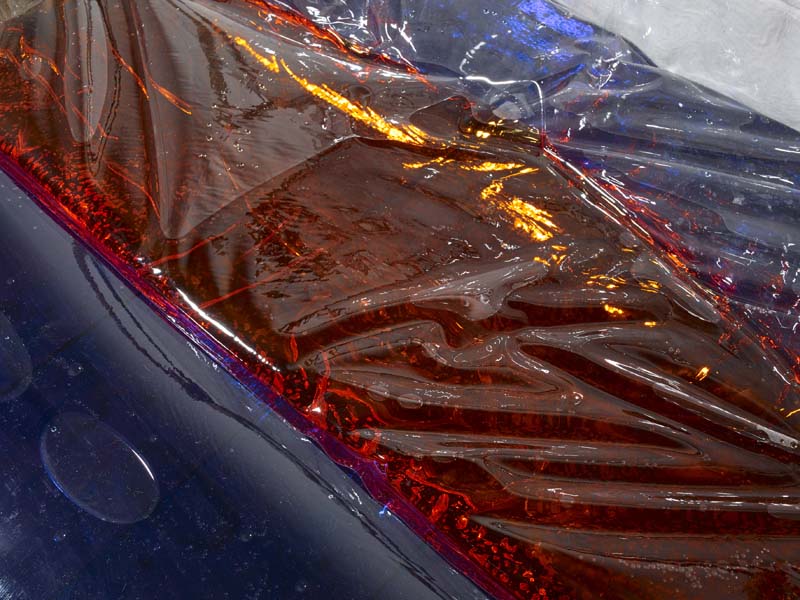 Senga Nengudi
Senga Nengudi
Water Composition III, 1969–70/2018 (detail)
Heat sealed vinyl, coloured water, rope
35 7/8 × 47 1/4 × 28 3/4 in. (91 × 120 × 73 cm)
© Senga Nengudi, 2022
Courtesy of Sprüth Magers and Thomas Erben Gallery, New York
Photo: Stephen White
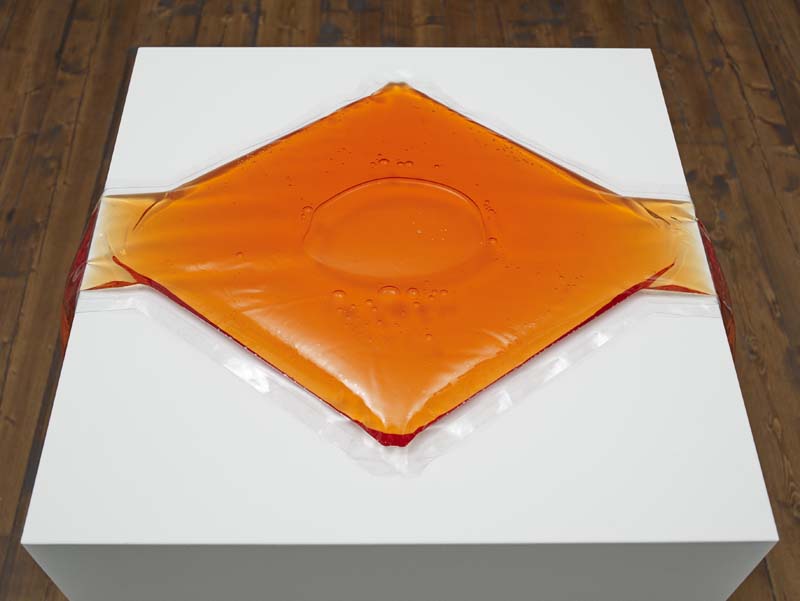 Senga Nengudi
Senga Nengudi
Water Composition (orange), 1969–70/2018 (detail)
Heat sealed vinyl, coloured water
7/8 × 38 1/8 × 15 3/4 in. (2 × 97 × 40 cm)
© Senga Nengudi, 2022
Courtesy of Sprüth Magers and Thomas Erben Gallery, New York
Photo: Stephen White
Before that moment, Nengudi had already faced the challenge of political criticism from peers, with her early Water Composition series (1970), clear vinyl sacks filled with water and tinted with shades of red, purple, green, and blue. Of them, David Hammons later recalled, “This was the Sixties. No one would even speak to her because we were all doing political art. She couldn’t relate. She wouldn’t even show around other black artists because her work was so ‘outrageously’ abstract.”4 Likewise—and contrary to Hammons’s assertion that Nengudi did not show with other Black artists—these sculptures were included the 1971 exhibition 8 artistes afro-américains at the Musée Rath in Geneva, Switzerland, where they were met with protests because the art included (by Romare Bearden, Bob Thompson, and others in addition to Nengudi) was not considered political enough. 5
Nengudi stopped making the Water Compositions in 1971, later attributing the reason for her abandonment to the sudden popularity of waterbeds, rather than the criticism she had received. 6 (Her explanation offers an illustration of the sly humor that runs throughout her work.) Yet the Water Compositions introduce characteristics and themes that would persist in her best-known body of work, the long-running series R.S.V.P. (1975-ongoing), discussed below. The colorful vinyl sacks have been frequently likened to bodies in the way that their forms shift and move. Nengudi herself described them as “the beginning of my sensual self,” as they highlighted the connection between living body and sculptural form. 7 This connection was deepened through activations based on physical encounter: the pliable sculptures were designed to be touched and moved by the viewer: “I really wanted to have something that people could feel and that had a sense of the body.” 8 That sense of a body connects Nengudi’s work to emerging feminist art, an artistic context in which softness, touch, and movement resonate with political concerns.
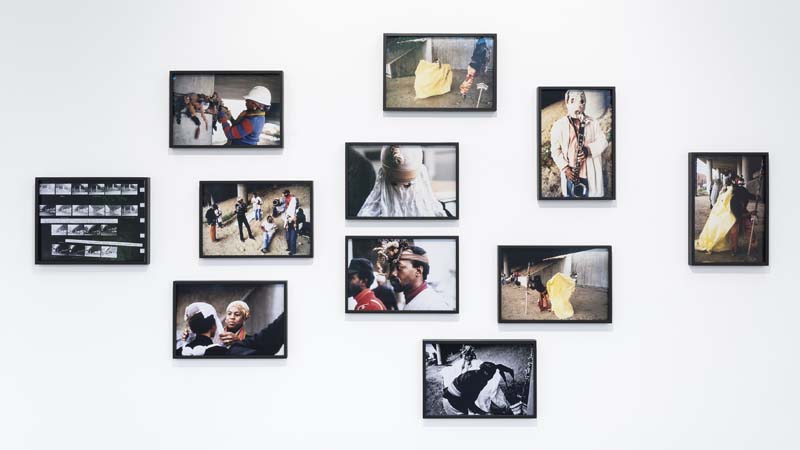
Senga Nengudi
Ceremony for Freeway Fets, 1978
10 c-prints, contact sheet
Dimensions variable
Photographer: Quaku / Roderick Young
© Senga Nengudi, 2022
Courtesy of Sprüth Magers and Thomas Erben Gallery, New York
Nengudi’s intention for the viewer to handle the Water Compositions rejects the concept of the solitary artistic creator, and she later became a member of Studio Z, an influential Los Angeles collective of artists, filmmakers, and musicians. Several of these became Nengudi’s frequent collaborators, including sculptors Hammons and, especially, Maren Hassinger. Working with them and members of Studio Z, Nengudi staged the 1978 performance Ceremony for Freeway Fets underneath a freeway overpass in Los Angeles on Pico Boulevard near the Los Angeles Convention Center, which had opened just a few years prior in 1971. Situated in a kind of non-place, this plot of land typically glimpsed from the car window while driving by was made into a mythic space: Nengudi has said she was drawn to the location because the tiny palms and shrubs amid the dirt and concrete “had a sense of Africa.” 9 Unrehearsed and improvisational, the performance involved Hammons and Hassinger enacting male and female spirits amid an installation of Nengudi’s nylon stocking sculptures. Combining her interests in Japanese culture, notably Kabuki theater, Yoruba ritual, and other diasporic practices, Nengudi established—if only for a moment during the performance—a Black space that imagined a possible new future. By locating her work in this public place that was desolate, trash-ridden, and beneath infrastructure that had displaced a community in the name of “progress,” Nengudi created a political work that implicitly addressed issues of racism, segregation, and gentrification, expanding and disrupting the idea of what constitutes a political artist.
In a performance protesting the tokenization of Black women artists in exhibitions devoted to feminist art, Nengudi, along with Hassinger, staged Spooks Who Sat at the Door on the steps of the Long Beach Museum of Art in 1983, which had mounted an exhibition of women artists but only included one Black woman, Hassinger. Nengudi and Hassinger stood outside the museum in silence, wearing white sheets and holding up products with Black stereotypes like Aunt Jemima pancake mix and Uncle Ben’s rice. As Nengudi recalled, “They didn’t get it. Once again we were invisible.” 10
Nengudi has further probed names as a signifier of race or ethnicity through her Personas (1998-present) an ongoing performance featuring alternate identities who work in different media: Propecia Leigh for photography, Harriet Chin for drawing, Lily B. Moor for writing. Growing out of an experience that caused her to examine her own bias—viewing an African-style painting created by an Asian artist—the Personas may be seen as an extension of the self-determined identity that began when the artist took on the name Senga Nengudi, and as a way to subvert expectations of what an artist’s work “should” look like based upon presumptions of their race, ethnicity, or culture.
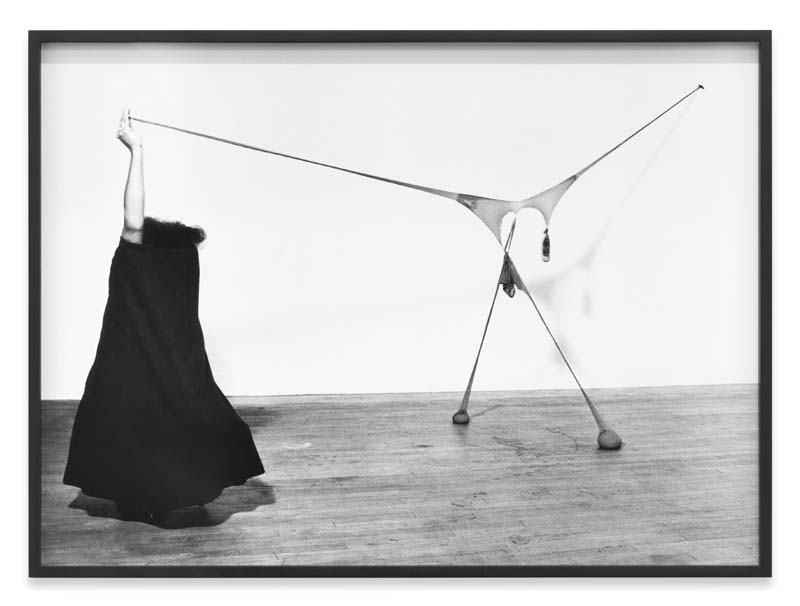 Senga Nengudi
Senga Nengudi
Studio performance with R.S.V.P., 1976
Silver gelatin print
29 × 40 in. (73.7 × 101.6 cm), framed: 30 × 41 in. (76.2 × 104.1 cm)
Photographer: Ken Peterson
© Senga Nengudi, 2022
Courtesy of Sprüth Magers and Thomas Erben Gallery, New York
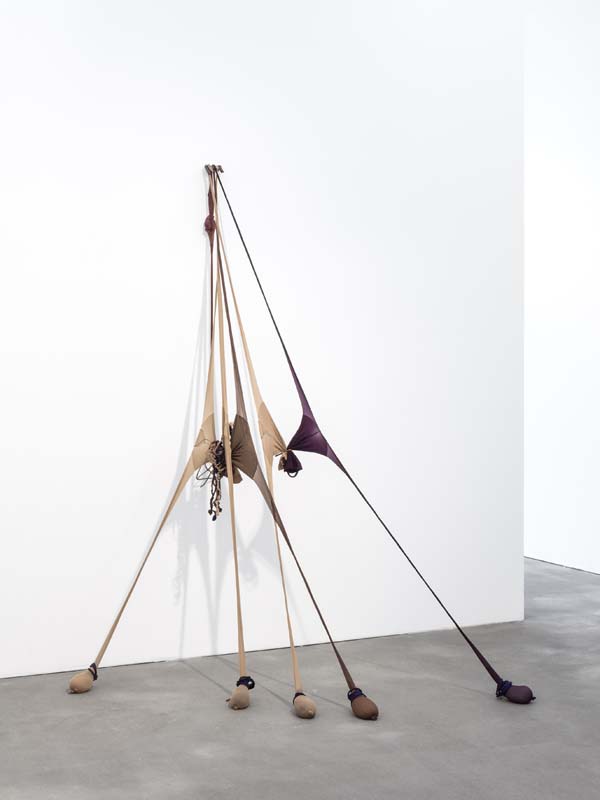 Senga Nengudi
Senga Nengudi
R.S.V.P. Reverie "Scribe", 2014
Nylon mesh, sand and found metals
91 × 54 × 67 in. (231 × 137 × 170 cm)
© Senga Nengudi, 2022
Courtesy of Sprüth Magers and Thomas Erben Gallery, New York
Photo: Timo Ohler
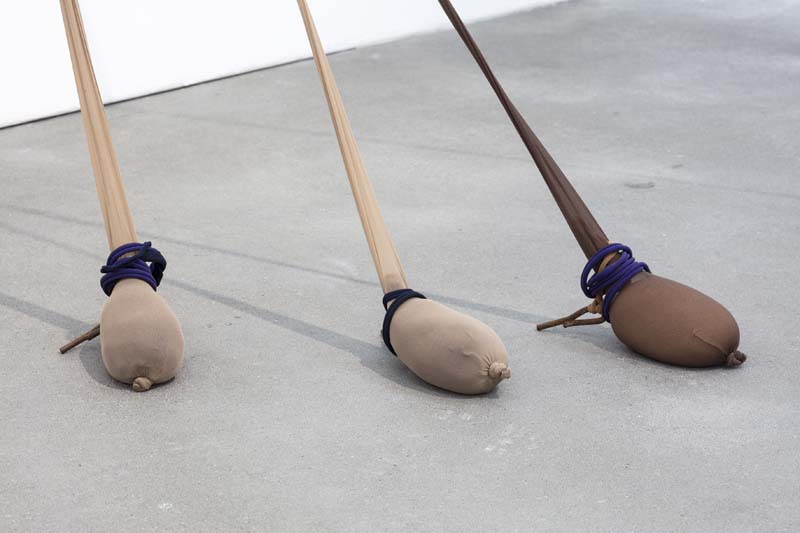 Senga Nengudi
Senga Nengudi
R.S.V.P. Reverie "Scribe", 2014 (detail)
Nylon mesh, sand and found metals
91 × 54 × 67 in. (231 × 137 × 170 cm)
© Senga Nengudi, 2022
Courtesy of Sprüth Magers and Thomas Erben Gallery, New York
Photo: Timo Ohler
Despite her frequent sense of alienation, Nengudi continued to pursue abstract representations of issues that were deeply personal while at the same time universally experienced by women, artists, and Black Americans. The response she received to the Water Compositions likely informed the direction her work took after the mid-1970s, especially the R.S.V.P. series, which replaced the clear vinyl with brown pantyhose and the colored water with sand (in some cases), more emphatically evoking the body, in particular the Black female body. Like the Water Compositions, activation of Nengudi’s R.S.V.P. installations is also predicated on touch: the series title corresponds to the French phrase répondez-vous s’il vous plait (please respond). The sculptures are activated through contact between the living bodies of performers and the surrogate bodies of the sculpture – garments that once themselves contained living beings and were chosen for the “residue of energy” 11 left by their wearers. As part of these performances, the artist has said that the dancer’s role is to “partner with the sculpture,” 12 exploring the relationship of one body to another through movements that recall the rituals of interpersonal exchange.
Her work has continued to explore these themes in new and provocative ways. In Bulemia (1988), Nengudi deliberately misspelled the name of an eating disorder as a title for an installation and performance redefining the nature of creativity as a process of taking in material, then releasing it in an altered version expressing the artist’s concerns. Bulemia’s enclosed space was covered in newspapers—another ephemeral material—with dominance given to positive news concerning Black art, life, and history, its contents emphasized with swaths of gold paint. It was accompanied by “Double Think Bulemia: Mouth to Mouth: Conversations on Being, ” a satellite broadcast of music and conversation including Charles Abramson, Carol Blank, John Outterbridge, Darryl Sevad, Kaylynn Sullivan, SunRa, and Cecil Taylor. 13 For her recent A.C.Q. (Air Conditioning Queen), Nengudi returned to the central concept of the R.S.V.P. sculptures and coupled pantyhose with refrigerator parts, some of which were functional, stirring the air gently even as their mechanical forms and sharp edges created a powerful contrast with the presumably more fragile nylon mesh. Sandmining B (2020) creates an environment of sand, populated with metal objects, knotted nylon mesh, and sprinklings of pigment suggesting both a detritus-filled landscape and the setting for a regenerative performance. In fact, Sandmining B builds upon Nengudi’s own tradition, since the 1990s, of creating works with sand that draw upon varied rituals across cultures, such as Navajo sand painting and the creation of Tibetan sand mandalas, with sand used as a means to restore a positive balance in the world. Nengudi has explored the mutability of the body throughout her career, utilizing materials that mimic anatomy or physically interact with performers and viewers. The artist’s training in dance brought her attention to perceptions of the human figure and made her keenly aware of the weight, placement, and kinetic potential of bodies in space. Nengudi has cited consideration of her own body as a shaping force in her career, describing how the physical demands of dance and her failure to conform to the willowy figure idealized in the dance world guided her instead to a sculptural practice. In 1974 after the birth of her first son, Nengudi became fascinated by the resiliency of her pregnant body and began in her R.S.V.P. series to work with media that could capture the elasticity, skin tones, and form of flesh. Pulled taut, weighted and swollen with sand, pantyhose worn by loved ones and strangers could become a stand-in for the bodies of women in high-pressure situations, Black wet-nurses with bodies drained and reshaped by suckling infants, perfection-seekers who modify their appearance through surgery, or aging bodies showing the effects of time and gravity. Nengudi describes the character of nylon mesh as an analog to flesh, “From tender, tight beginnings to sagging end ... The body can only stand so much push and pull until it gives way, never to resume its original shape.”14 Works such as Performance with R.S.V.P. (1976), Performance Piece (1977), and Ceremony for Freeway Fets (1978) activated Nengudi’s nylon mesh sculptures and often involved collaboration with her studio mates, particularly Hassinger. Nengudi continues to work with other artists and dancers in the creation of new performances that activate the sculptures and expand their realm of signification.
Furthermore, the ephemeral nature of performance has made documentation an essential element in Nengudi’s practice (as well as those of her contemporaries). Many of her works are only known to us now through photographic and film recordings and the artist’s notes, including Rapunzel (1981), a performance staged at an old Catholic school being demolished, in which Nengudi assumed the guise of the fairy tale heroine trapped in a tower by donning a head-and-face piece made with nylon mesh and a remnant of one of Hammons’s works involving human hair. In fact, early works, like Performance with R.S.V.P. and Performance Piece were initially presented not for an audience but for the camera. Later collaborative and performative works would be staged for audiences but were also documented.
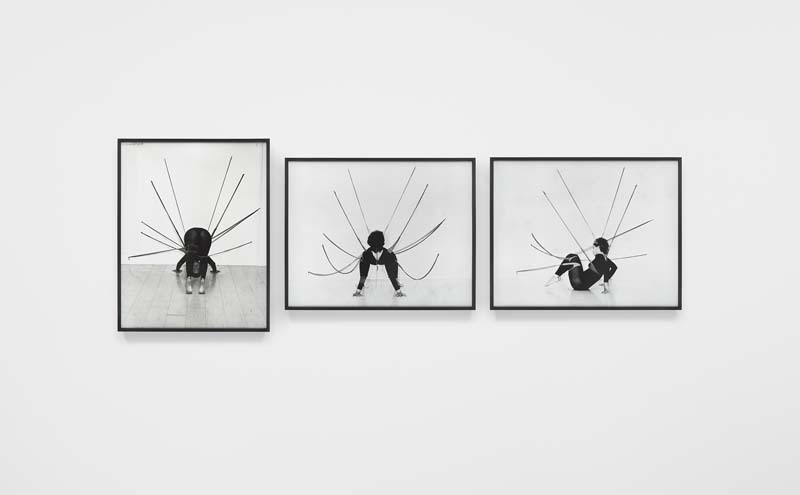
Senga Nengudi
Performance Piece, 1978
Silver gelatin prints, triptych
118 3/8 × 41 in. (300.8 × 104.1 cm)
Photographer: Harmon Outlaw
© Senga Nengudi, 2022
Courtesy of Sprüth Magers and Thomas Erben Gallery, New York
Nengudi’s work as a whole is radically ephemeral, particularly for sculpture, in its creation and activation as well as in its materials and forms. The R.S.V.P. sculptures were never intended to be preserved in perpetuity. They were, in the words of the artist, “experiments” presented for a viewer to experience, the title offering an invitation to relate to the sculptures, not physically as in the performances, but intellectually. “Making objects that will last lifetimes…has never been a priority for me,” Nengudi noted in 1993. “My purpose is to create an experience that will vibrate with the connecting thread.” 15
About Senga Nengudi
Senga Nengudi was born in 1943 in Chicago, Illinois; she lives and works in Colorado Springs, Colorado. Nengudi’s work has been the subject of solo exhibitions organized by Henry Moore Institute (2018); the Baltimore Museum of Art (2018); Art + Practice, Los Angeles (2018); the Institute of Contemporary Art, Miami (2017); and the Contemporary Arts Center, New Orleans (2017), as well as her recent retrospective, Topologies, which originated at the Lenbachhaus, Munich in 2019 and traveled to Denver Art Museum, Denver (2020); Museu de Arte de São Paulo, Brazil (2020); and the Philadelphia Museum of Art, Philadelphia (2021). Her work has been prominently featured in international biennials including the 57th Venice Biennale (2017) and the 54th Carnegie International (2007).
Nengudi was elected as a member of the American Academy of Arts and Sciences in 2020 and has been a recipient of Denver Art Museum Key Award (2019); Women’s Caucus For Art Lifetime Achievement Award (2010); and the Anonymous Was A Woman Award (2005). Her works are held in institutional collections including The Museum of Modern Art, New York; The Whitney Museum of American Art, New York; Studio Museum in Harlem, New York; The Brooklyn Museum, New York; Los Angeles County Museum of Art; The Hammer Museum, Los Angeles; The Carnegie Museum of Art, Pittsburgh; Musée National d'Art Moderne, Centre Georges Pompidou, Paris; Tate Modern, London; and Jerusalem Museum of Art, Jerusalem.
1 Senga Nengudi quoted in Anna Souter, “Being Born Black in America Is a Political Act”: An Interview With Senga Nengudi,” Hyperallergic, September 26, 2018: https://hyperallergic.com/462256/being-born-black-in-america-is-a-political-act-an-interview-with-senga-nengudi/ (accessed August 12, 2022).
2 Michel Tapié and Tore Haga, Avant-garde Art in Japan (New York: Harry N. Abrams, 1962).
3 “Senga Nengudi in conversation with Elissa Author: Excerpts from an oral history interview, Denver, Colorado, July 9-11, 2013,” in Stephanie Weber and Matthias Mühling, eds., Senga Nengudi: Topologien / Topologies (Hirmer: Lenbachaus / MASP, 2019), 291.
4 David Hammons quoted in Kellie Jones, “Interview with David Hammons,” Real Life Magazine 16 (Autumn 1986), 2.
5 The exhibition was organized by Henri Ghent, a Black curator and one of the co-founders of the Black Emergency Cultural Coalition, which formed in 1969 in response to the Metropolitan Museum of Art’s exhibition Harlem on My Mind, which had overlooked the work of Black artists.
Anna Straetmans, “Contextures—Connection, Background, and Influence,” in Senga Nengudi: Topologies, p. 325.
6 “Senga Nengudi in conversation with Elissa Author,” 289-90.
7 “Senga Nengudi in conversation with Elissa Author,” 289.
8 “Senga Nengudi in conversation with Elissa Author, 291.
9 Nick Stillman, “Senga Nengudi’s ‘Ceremony of Freeway Fets’ and other Los Angeles Collaborations,” East of Borneo, December 7, 2011: https://eastofborneo.org/articles/senga-nengudis-ceremony-for-freeway-fets-and-other-los-angeles-collaborations/ (accessed August 12, 2022).
10 Senga Nengudi in Joshua Chambers-Letson, “b.O.s. 2.4 / Spooks Who Sat By the Door,” ASAP Journal, June 18, 2018, https://asapjournal.com/b-o-s-2-4-spooks-who-sat-by-the-door-for-miriam-petty-joshua-chambers-letson/ (accessed August 12, 2022).
11 “Senga Nengudi Talks about Her Exhibitions in Denver,” Artforum, April 3, 2014, https://www.artforum.com/interviews/senga-nengudi-talks-about-her-exhibitions-in-denver-46049
12 Lovia Gyarkye, “An Artist's Continuing Exploration of the Human Form,” T Magazine, November 9, 2020, https://www.nytimes.com/2020/11/09/t-magazine/senga-nengudi-art.html.
13 “Double Think Bulemia” on the the African American Performance Art Archive, https://aapaa.org/artists/senga-nengudi/senga-nengudi-doube-think-bulimia/.
14 Senga Nengudi, Statement on nylon mesh works, 1977, Amistad Research Center, New Orleans, Senga Nengudi Papers, 1966-2017.
15 Senga Nengudi, Artist Statement, 1995, Thomas Erben archives, New York; reprinted in Senga Nengudi: Topologies, 242.
Utilizando materiales tan inesperados como medias de nylon usadas y arena, la ganadora del Premio Nasher 2023, Senga Nengudi, crea un arte que atraviesa las disciplinas de la escultura y la danza para producir obras que hablan acerca de la fragilidad y la resiliencia del cuerpo humano, de nuestra capacidad de acción como individuos, y de la importancia de la colaboración y la amistad.
A lo largo de más de cinco décadas, Nengudi ha desarrollado una práctica que combina objetos e instalaciones poéticos y enigmáticos con performances, películas y fotografías que exploran las interacciones de los artistas con sus obras tridimensionales y en medio de ellas. A pesar de una larga y rica carrera de más de cinco décadas, apenas recientemente se le ha prestado atención, y sus logros tienen una fuerte repercusión en el arte contemporáneo.
El comienzo de la carrera de Nengudi, a mediados de la década de 1960, coincidió con un período tumultuoso de la historia de Estados Unidos, que incluyó el movimiento por los derechos civiles, así como el inicio del movimiento de las mujeres y la segunda ola del feminismo. Estos acontecimientos fueron formativos para la artista, que continuaría produciendo obras efímeras, a menudo abstractas, basadas en la performance y, con frecuencia, en colaboración, abordando temas como la raza, el género y la etnia, así como el trabajo y el paso del tiempo. Las intersecciones de las apasionadas, y a veces conflictivas, preocupaciones políticas entre compañeros, colegas y la sociedad en general, produjeron un clima de debate, a menudo tenso, acerca de las formas más efectivas para que los artistas abordaran los problemas a los que se enfrentaba la sociedad
Al igual que otros artistas negros que trabajan en la abstracción, algunos consideraron que Nengudi carecía de urgencia política o de un mensaje específico debido a su uso de la evocación, más que de la representación directa, para abordar los problemas a los que se enfrentan los negros estadounidenses. A pesar de la inicial oposición a sus esfuerzos, Nengudi ha procedido durante las décadas siguientes a desarrollar una práctica artística generosa y versátil que demuestra cómo la escultura abstracta puede abordar cuestiones políticas con compasión, humor y una diversa comunidad de aliados. De hecho, ha ampliado nuestra idea de lo que puede considerarse político en una obra de arte. Como explicó en 2018, "simplemente por ser, es una declaración política. Así que, cualquier cosa que salga de mí tiene todos esos elementos míos en ella: Soy negra, soy una mujer, en este momento soy una mujer de cierta edad, que también tiene temas relacionados con ella. Así que simplemente por ser, soy esas cosas.” 1
Nacida en 1943 como Sue Ellen Irons en Chicago, Illinois, Nengudi creció principalmente en la costa oeste, en Pasadena y Los Ángeles. Su temprano interés por el arte y la danza la llevó a estudiar ambas cosas, lo que le valió una licenciatura en arte con una mención en danza en el Los Angeles State College, seguida de un máster en escultura en la misma institución, que para entonces había cambiado su nombre a California State College, Los Ángeles. Además de su educación formal, Nengudi ha señalado que sus experiencias en la enseñanza han sido fundamentales para su desarrollo, especialmente el tiempo que pasó a mediados de los años 60 en el Watts Towers Art Center, fundado por el artista Noah Purifoy en el barrio negro de Watts tras el levantamiento de 1965, cerca del fantástico complejo construido por Simon Rodia a partir de objetos encontrados. La educación ha seguido siendo importante para Nengudi, quien continuó enseñando hasta su jubilación en 2008 en el Departamento de Artes Visuales y Escénicas de la University of Colorado, Colorado Springs (UCCS).
En sus años de formación, Nengudi se inspiró en un amplio espectro de arte. Como educadora en el Pasadena Art Museum, conoció esculturas de algunos de los artistas contemporáneos más importantes de la época, como Claes Oldenburg, Craig Kauffman y Richard Serra. Y lo que es más importante, estas obras se mostraban en el contexto de un programa de exposiciones variado e intercultural, que abarcaba desde el modernismo europeo hasta la pintura japonesa y los tejidos ghaneses. También se inspiró en el ejemplo de una generación algo mayor de artistas negros que trabajaban en California, como Melvin Edwards y Betye Saar. Un libro acerca de la vanguardia japonesa la introdujo en el grupo Gutai, cuyo movimiento artístico radicalmente experimental en el Japón de la posguerra, desafiaba los medios tradicionales de creación haciendo hincapié en materiales no convencionales, en el proceso más allá de las obras de arte terminadas, y en nuevos contextos para el arte. 2
La fascinación de Nengudi por el Gutai la impulsó a realizar un programa de postgrado en Japón en 1966. Aunque no experimentó las obras o los artistas de Gutai en persona, el viaje la puso en contacto con el teatro tradicional Noh y Kabuki. Éstos desempeñarían un papel importante en el desarrollo de su enfoque de la actuación, al igual que el creciente interés del Movimiento de las Artes Negras por las formas tradicionales del arte africano y su relación con el ritual. Aunque Nengudi no se involucró en los mensajes políticos directos de algunos de sus compañeros, la experiencia africana de la diáspora fue clave en su concepción de la identidad y la práctica artística. En 1974, tras tres años en New York, regresó a Los Ángeles con el nombre por el que hoy se la conoce: Senga, como ella misma ha explicado, significa "mujer del pueblo a la que la gente acude [en busca de consejo]" en la lengua de Douala (Camerún), mientras que Nengudi connota una mujer que "llega al poder como curandera tradicional.” 3
La intención de Nengudi de que el espectador manipule las Water Compositions (Composiciones de Agua, en Español) rechaza el concepto del creador artístico solitario, y más tarde se convirtió en miembro de Studio Z, un influyente colectivo de artistas, cineastas y músicos de Los Ángeles. Varios de ellos se convirtieron en colaboradores frecuentes de Nengudi, como los escultores Hammons y, especialmente, Maren Hassinger. Con ellos y con los miembros de Studio Z, Nengudi montó en 1978 la performance Ceremony for Freeway Fets(Ceremonia para Fetos de la Autopista, en Español) bajo un paso elevado de la autopista de Los Ángeles, en Pico Boulevard, cerca de Los Angeles Convention Center, que se había inaugurado pocos años antes, en 1971. Situada en una especie de no-lugar, esta parcela que normalmente se ve desde la ventanilla del automóvil al pasar por allí se convirtió en un espacio mítico: Nengudi ha dicho que se sintió atraída por el lugar porque las pequeñas palmeras y arbustos en medio de la tierra y el hormigón "poseían una sensación de África” 9 Sin ensayar y de manera improvisada, la actuación incluía a Hammons y Hassinger representando espíritus masculinos y femeninos en medio de una instalación de esculturas de medias de nylon de Nengudi. Combinando sus intereses en la cultura japonesa, especialmente el teatro Kabuki, el ritual Yoruba y otras prácticas diaspóricas, Nengudi estableció -aunque sólo fuera por un momento durante la actuación- un espacio negro que imaginaba un posible nuevo futuro. Al situar su obra en este lugar público desolado, lleno de basura y bajo una infraestructura que había desplazado a una comunidad en nombre del "progreso", Nengudi creó una obra política que abordaba implícitamente cuestiones de racismo, segregación y gentrificación, ampliando y desbaratando la idea de lo que constituye un artista político.
En una actuación para protestar por la simbolización de las artistas negras en las exposiciones dedicadas al arte feminista, Nengudi, junto con Hassinger, escenificó Spooks Who Sat at the Door (Fantasmas que se Sentaron en la Puerta, en Español) en las escaleras del Long Beach Museum of Art en 1983, que había montado una exposición de mujeres artistas pero sólo incluía a una mujer negra, Hassinger. Nengudi y Hassinger se quedaron afuera del museo en silencio, vistiendo sábanas blancas y sosteniendo productos con estereotipos negros como la mezcla para pancakes Aunt Jemima y el arroz Uncle Ben's. Como recuerda Nengudi, "no lo entendieron. Una vez más éramos invisibles.” 10
Nengudi ha seguido investigando los nombres como significantes de raza o etnia a través de su espectáculo Personas (1998-actualidad), que presenta identidades alternativas que trabajan en diferentes medios: Propecia Leigh en fotografía, Harriet Chin en dibujo y Lily B. Moor en escritura. Nacida de una experiencia que la llevó a examinar sus propios prejuicios –al ver una pintura de estilo africano creada por un artista asiático- las Personas pueden verse como una extensión de la identidad autodeterminada que comenzó cuando la artista adoptó el nombre de Senga Nengudi, y como una forma de subvertir las expectativas de cómo "debería" verse la obra de un artista basándose en presunciones de su raza, etnia o cultura.
A pesar de su frecuente sensación de alienación, Nengudi continuó representando de forma abstracta temas profundamente personales y, al mismo tiempo, universalmente experimentados por las mujeres, los artistas y los negros estadounidenses. La respuesta que recibió a las Water Compositions probablemente influyó en la dirección que tomó su obra a partir de mediados de la década de 1970, especialmente la serie R.S.V.P., que sustituyó el vinilo transparente por pantimedias marrones y el agua coloreada por arena (en algunos casos), evocando con mayor énfasis el cuerpo, en particular el cuerpo femenino negro. Al igual que las Water Compositions, la activación de las instalaciones R.S.V.P. de Nengudi también se basa en el tacto: el título de la serie corresponde a la frase francesa répondez-vous s'il vous plait (responda, por favor). Las esculturas se activan mediante el contacto entre los cuerpos vivos de los intérpretes y los cuerpos sustitutos de la escultura, prendas que en su día contenían seres vivos y que fueron elegidas por su " residuo de energía.” 11 que dejan sus usuarios. Como parte de estas actuaciones, la artista ha dicho que el papel del bailarín es "asociarse con la escultura,” 12 explorando la relación de un cuerpo con otro a través de movimientos que recuerdan los rituales del intercambio interpersonal.
Su obra ha seguido explorando estos temas de formas nuevas y provocativas. En Bulemia (1988), Nengudi escribió deliberadamente mal el nombre de un trastorno alimentario como título de una instalación y una performance que redefinía la naturaleza de la creatividad como un proceso de toma de material, para luego liberarlo en una versión alterada que expresaba las preocupaciones de la artista. El espacio cerrado de Bulemia estaba cubierto de periódicos -otro material efímero- en los que predominaban noticias positivas acerca del arte, la vida y la historia de los negros, y su contenido se destacaba con franjas de pintura dorada. Se acompañaba de "Double Think Bulemia: Mouth to Mouth: Conversations on Being" (Piensa Dos Veces en la Bulemia: Boca a Boca: Conversaciones Acerca del Ser, en Español), una transmisión por satélite de música y conversación en la que participaron Charles Abramson, Carol Blank, John Outterbridge, Darryl Sevad, Kaylynn Sullivan, SunRa y Cecil Taylor. 13 Para su reciente A.C.Q. (Air Conditioning Queen), Nengudi retomó el concepto central de las esculturas R.S.V.P. y acopló pantimedias con piezas de frigoríficos, algunas de las cuales funcionaban, agitando el aire suavemente incluso cuando sus formas mecánicas y bordes afilados creaban un poderoso contraste con la malla de nylon, presumiblemente más frágil. Sandmining B (2020) crea un entorno de arena, poblado de objetos metálicos, malla de nylon anudada y salpicaduras de pigmentos que sugieren tanto un paisaje lleno de detritus como el escenario de una performance regenerativa. De hecho, Sandmining B se basa en la propia tradición de Nengudi, desde la década de 1990, de crear obras con arena que se inspiran en diversos rituales de distintas culturas, como la pintura de arena de los navajos y la creación de mandalas de arena tibetanos, en los que la arena se utiliza como medio para restablecer un equilibrio positivo en el mundo. Nengudi ha explorado la mutabilidad del cuerpo a lo largo de su carrera, utilizando materiales que imitan la anatomía o interactúan físicamente con los artistas y los espectadores. La formación de la artista en danza le hizo prestar atención a las percepciones de la figura humana y la hizo muy consciente del peso, la ubicación y el potencial cinético de los cuerpos en el espacio. Nengudi ha citado la consideración de su propio cuerpo como una fuerza que ha moldeado su carrera, describiendo cómo las exigencias físicas de la danza y su incapacidad para ajustarse a la silueta idealizada en el mundo de la danza la guiaron hacia la práctica escultórica. En 1974, tras el nacimiento de su primer hijo, Nengudi se sintió fascinada por la resistencia de su cuerpo de embarazada y comenzó a trabajar en su serie R.S.V.P. con medios que pudieran capturar la elasticidad, los tonos de la piel y la forma de la carne. Tensadas, lastradas e hinchadas por la arena, las medias usadas por seres queridos y extraños, podían convertirse en un sustituto de los cuerpos de las mujeres en situaciones de gran presión, de las nodrizas negras con los cuerpos drenados y remodelados por los bebés lactantes, de las buscadoras de la perfección que modifican su aspecto mediante la cirugía, o de los cuerpos envejecidos que muestran los efectos del tiempo y la gravedad. Nengudi describe el carácter de la malla de nylon como un análogo de la carne: "De los comienzos tiernos y apretados al final flácido... El cuerpo sólo puede soportar un número determinado de empujones y tirones hasta que cede, para nunca retomar su forma original.”14 Trabajos como Performance with R.S.V.P. (1976), Performance Piece (1977), y Ceremony for Freeway Fets (1978) activaron las esculturas de malla de nylon de Nengudi y a menudo implicaron la colaboración con sus compañeros de estudio, en particular con Hassinger. Nengudi sigue trabajando con otros artistas y bailarines en la creación de nuevas performances que activan las esculturas y amplían su ámbito de significación.
Además, la naturaleza efímera de la performance ha hecho de la documentación un elemento esencial en la práctica de Nengudi (así como en la de sus contemporáneos). Muchas de sus obras sólo las conocemos a través de grabaciones fotográficas y fílmicas y de las notas de la artista, como Rapunzel (1981), una performance montada en una antigua escuela católica en proceso de demolición, en la cual Nengudi asumió el papel de la heroína de un cuento de hadas atrapada en una torre, poniéndose una pieza de cabeza y cara hechas con malla de nylon y un remanente de una de las obras de Hammons con cabello humano. De hecho, las primeras obras, como Performance with R.S.V.P. y Performance Piece, se presentaron inicialmente no para el público, sino para la cámara. Más tarde, las obras colaborativas y performativas se escenificaron para el público, pero también se documentaron.
El conjunto de la obra de Nengudi es radicalmente efímero, especialmente para la escultura, tanto en su creación y activación como en sus materiales y formas. Las esculturas R.S.V.P. nunca estuvieron destinadas a ser conservadas a perpetuidad. Eran, en palabras de la artista, "experimentos" que se presentaban para que el espectador los experimentara, ofreciendo el título una invitación a relacionarse con las esculturas, no físicamente como en las performances, sino intelectualmente. "Hacer objetos que duren por vidas... nunca ha sido una prioridad para mí", señaló Nengudi en 1993. "Mi propósito es crear una experiencia que vibre con el hilo conductor.” 15
Acerca de Senga Nengudi
Senga Nengudi nació en 1943 en Chicago, Illinois; vive y trabaja en Colorado Springs, Colorado. La obra de Nengudi ha sido objeto de exposiciones individuales organizadas por el Henry Moore Institute (2018); el Baltimore Museum of Art (2018); Art + Practice, Los Ángeles (2018); el Institute of Contemporary Art, Miami (2017); y el Contemporary Arts Center, Nueva Orleans (2017), así como su reciente retrospectiva, Topologies, que se originó en el Lenbachhaus, Múnich, en 2019 y viajó al Denver Art Museum, Denver (2020); Museu de Arte de São Paulo, Brasil (2020); y el Philadelphia Museum of Art, Filadelfia (2021). Su obra ha sido destacada en bienales internacionales como la 57ª Bienal de Venecia (2017) y la 54ª Carnegie International (2007).
Nengudi fue elegida miembro de la American Academy of Arts and Sciences en 2020 y ha recibido el Denver Art Museum Key Award (2019); el Women's Caucus For Art Lifetime Achievement Award (2010); y el Anonymous Was A Woman Award (2005). Sus obras forman parte de colecciones institucionales como el Museum of Modern Art, New York; The Whitney Museum of American Art, New York; Studio Museum in Harlem, New York; The Brooklyn Museum, New York; Los Angeles County Museum of Art; The Hammer Museum, Los Angeles; The Carnegie Museum of Art, Pittsburgh; Musée National d'Art Moderne, Centre Georges Pompidou, de Paris; Tate Modern, London; y Jerusalem Museum of Art, Jerusalem.
1 Senga Nengudi citada por Anna Souter, "Being Born Black in America Is a Political Act": An Interview With Senga Nengudi" (Nacer Negro en América es un Acto Político: Una Entrevista Con Senga Nengudi, en Español), Hyperallergic, 26 de Septiembre de 2018: https://hyperallergic.com/462256/being-born-black-in-america-is-a-political-act-an-interview-with-senga-nengudi/ (accessed August 12, 2022).
2 Michel Tapié y Tore Haga, Avant-garde Art en Japón (New York: Harry N. Abrams, 1962).
3 “Senga Nengudi en conversación con Elissa Author: Extractos de una entrevista de historia oral, Denver, Colorado, 9-11 de Julio de 2013", en Stephanie Weber y Matthias Mühling, eds., Senga Nengudi: Topologien / Topologies (Hirmer: Lenbachaus / MASP, 2019), 291.
4 David Hammons citado por Kellie Jones, “Interview with David Hammons,” (Entrevista con David Hammons, en Español) Real Life Magazine 16 (Otoño 1986), 2.